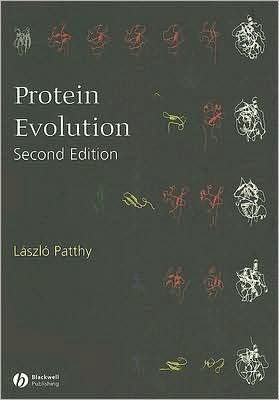Protein Evolution
This book provides an up-to-date summary of the principles of protein evolution and discusses both the methods available to analyze the evolutionary history of proteins as well as those for predicting their structure-function relationships.\ \ \ Includes a significantly expanded chapter on genome evolution to cover genomes of model organisms sequenced since the completion of the first edition, and organelle genome evolution\ Retains its reader-friendly, accessible style and organization\...
Search in google:
The flood of information on gene and protein sequences from the genome projects has revolutionized molecular and evolutionary biology and led to the rapid development of the science called genomics. Reliable prediction of the function of a novel gene/protein requires complex computational analysis of genomic and protein sequence information which exploit the principles governing the evolution of protein structure and function.This book provides an up-to-date summary of the principles of protein evolution and discusses both the methods available to analyze the evolutionary history of proteins as well as those for predicting their structure–function relationships. This second edition, while retaining its accessible style and reader-friendly organization, is completely updated and boasts a new glossary and updated references. The chapter on genome evolution has been significantly expanded in order to cover genomes of model organisms sequenced since the completion of the first edition. Protein Evolution is ideal for senior undergraduates and graduate students taking courses in protein structure and evolution, as well as bioinformatics. It will also be a useful supplement for students taking wider courses in molecular evolution, as well as a valuable resource for professionals in the area of functional genomics.
Preface to the first edition ixPreface to the second edition xiAcknowledgements xiiiIntroduction xvProtein-Coding Genes 1A Structure of protein-coding genes 2Transcription 3Translation 10References 14Useful internet resources 15Protein Structure 18The polypeptide backbone 18The amino acids 18Covalent modifications of amino acid side chains 23Enzymatic modifications 23Nonenzymatic chemical modifications 27Interactions that govern protein folding and stability 28Noncovalent interactions 28The hydrophobic interaction 29Secondary structural elements 30The [alpha]-helix 30[beta]-sheets 31Reverse turns 32Supersecondary structures 32Tertiary structures of proteins 33Globular proteins 33Fibrous proteins 35Unusual structures of internally repeated proteins 36Secreted proteins and membraneproteins 37Intrinsically disordered proteins 40Multidomain proteins 40Multisubunit proteins 40References 41Useful internet resources 41Mutations 45Types of mutations 45Substitutions 45Deletion, duplication, insertion and fusion 48Factors affecting rates of mutation 50The fate of mutations 52The molecular clock 59References 61Useful internet resources 62Evolution of Protein-Coding Genes 63Alignment of nucleotide and amino acid sequences 63Estimating the number of nucleotide substitutions 65Substitutions in translated regions 67Substitutions in untranslated regions, introns and 5[prime] and 3[prime] flanking regions of protein-coding genes 68Rates and patterns of nucleotide substitution 68Rates of nucleotide substitution 69Variation in substitution rates 71Variation among different sites of the translated region 72Variation among genes 74Constancy and variation in substitution rates of orthologous genes 75Nonrandom substitutions at synonymous positions 76Molecular phylogeny 78Phylogenetic trees 78Tree reconstruction 79Tree-making methods 81Estimation of species-divergence times 85References 85Useful internet resources 87Evolution of Orthologous Proteins 89Orthologous proteins with the same function in different species 91Orthologous proteins with modified function in different species 94Orthologous proteins with major modification of function 98Orthologous proteins that have lost their function 98Orthologous proteins that have gained additional functions 99Prediction of the function of orthologous proteins 99The three-dimensional structure of orthologous proteins 100Prediction of secondary structure of proteins 100Prediction of the three-dimensional structure of proteins 102Detecting sequence homology of protein-coding genes 103References 104Useful internet resources 105Formation of Novel Protein-Coding Genes 108De novo formation of novel protein-coding genes 108Gene duplications 110Mechanisms of gene duplication 111Fate of duplicated genes 117Fate of genes acquired by lateral gene transfer 121Dating gene duplications 121References 124Useful internet resources 125Evolution of Paralogous Proteins 126Advantageous duplications 127Unprocessed genes 127Processed genes 127Neutral duplications 130Modification of function by point mutations 132Major change of function by point mutations 140Major change of function by domain acquisitions 143Similarities and differences in the evolution of paralogous and orthologous proteins 147Predicting the function of proteins by homology 150Nonhomology-based methods for the prediction of the function of proteins 151Detecting distant homology of protein-coding genes 152Delecting distant homology by consensus approaches 152Detecting distant homology by comparing three-dimensional structures 161Detecting distant homology by comparing exon-intron structures 162References 163Useful internet resources 166Protein Evolution by Assembly from Modules 170Modular assembly by intronic recombination 171Introns 173Internal gene duplications/deletions via recombination in introns 182Fusion of genes via recombination in introns 183Exon shuffling via recombination in introns 183Factors affecting acceptance of mutants created by intronic recombination 192Classification of modules and mosaic proteins produced by exon shuffling 199Genome evolution and the evolution of exon shuffling 207Evolutionary significance of exon shuffling 209Genome evolution and the evolution of alternative splicing 211Modular assembly by exonic recombination 211References 213Useful internet resources 216Genome Evolution and Protein Evolution 218Evolution of genome size 218The role and survival of nongenic DNA 221Repetitiveness of genomic DNA 221Mechanisms responsible for increases in genome size 223Compositional organization of eukaryotic genomes 224Genomes of model organisms 225Viral genomes 226Cellular genomes 230Eubacterial genomes 231Archaeal genomes 238Organelle genomes 241Eukaryotic genomes 244Genome duplications in the evolution of early vertebrates 271Value of comparative genomics for the identification of functional elements 276Finding protein-coding genes in genome sequences 277The genome of the cenancestor 280Changes in gene number and gene density in different evolutionary lineages 280Proteome evolution 282Proteome evolution - classification of proteins by structural features 282Proteome evolution - classification of proteins by homology 283Proteome evolution - classification of proteins by function 283Proteome evolution - evolution of proteome complexity 287Proteome evolution and organismic complexity 291References 293Useful internet resources 302Glossary 309Index 367








